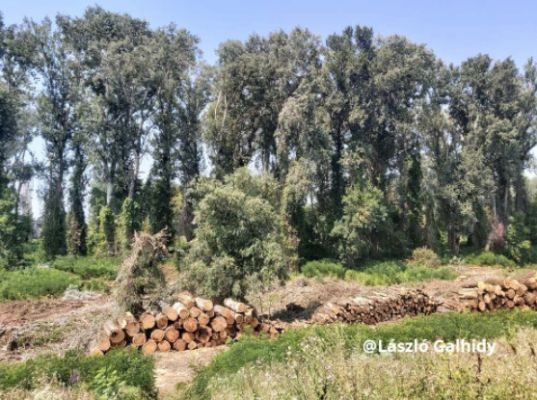100-Year-Old Hungarian Forest At Tiszaug Falls Victim To Illegal Clear-Cutting, Again

Another illegal clear-cutting took place in a protected state forest area near Tiszaug in August. There was no serious prosecution after the first incident in January. According to WWF-Hungary, the current sad example also proves that as long as flood control and river basin management methods of are not reviewed, similar habitat destruction may occur in the future.
WWF-Hungary drew attention to the severe destruction of natural resources at Tiszaug at the beginning of 2020.
During the implementation of the Hungarian National Directorate of Water Management’s “VTT River Bank Management in the Middle Tisza Project,” a part of the forest was clear-cut that, according to the environmental permit of the project, should have been explicitly preserved. The lumberjacks destroyed very rare old poplars and a floodplain habitat in the state-owned Natura 2000 protected area. The subcontractor was obliged by the Bács-Kiskun County Government Office to pay a ridiculously small fine of HUF 187,500 (EUR 525), while the market value of a single black poplar is many times that.
In August, chainsaws were at work again, this time in the Tiszaug 1/C4 forest section. Logging once more took place at a location where it was prohibited by environmental permit.
Not only old trees, but a multitude of protected plants and animals may have perished. It is a rare and sad sight to see old trees felled that used to provide excellent habitat for many bats and other species nesting in wood cavities, and which provided feeding grounds for black woodpeckers and spotted woodpeckers.
“The area of our floodplain forests has decreased to one percent compared to before river regulation. The now destroyed part of the forest with its old black poplar trees also represented a rare type of habitat. The felled logs, sometimes one metre in diameter, stacked on top of each other, is a horrifying sight,” said László Gálhidy, Forest Programme Coordinator, WWF-Hungary.
“Apparently, neither the requirements of the environmental permit nor a fine, however minimal, can prevent the destruction of our environment. Wasting our natural treasures is like selling Munkácsy’s masterpiece paintings for the price of gas,” said Péter Kajner, Living Rivers Programme Project Manager, Tisza River Area, WWF-Hungary.
This most recent incident is a good example of Hungary’s inconsistent flood control concept. While protected forests in the vicinity of Tiszaug are being cut down to speed up the course of floods, trees are being planted along the embankments in a planned flood control project on Óbuda (Hajógyári) Island that could increase flood levels in Budapest by 7-10 cm.
WWF-Hungary asks how many unlicensed clear-cuts are still needed to finally spur a review of the risks associated with the current flood control measures in Hungary? It is not enough to design the concept of flood protection in theory; its implementation must not cause irreparable losses to nature or people.
A form of flood protection is necessary that provides more space for rivers within the embankments by protecting waterfront habitat, and which helps to create new natural habitats beyond the embankments. “Using nature-based solutions would not endanger our last floodplain forests, but create new habitats. We could finally manage water instead of trying to get rid of it as soon as possible,” emphasised Péter Kajner.


 World Vision: 3.5 Million Displaced Following Myanmar Earthquake And Ongoing Internal Conflict
World Vision: 3.5 Million Displaced Following Myanmar Earthquake And Ongoing Internal Conflict World Butchers Challenge: World’s Top Butchers From 14 Nations Go Knife-to-Knife In Paris
World Butchers Challenge: World’s Top Butchers From 14 Nations Go Knife-to-Knife In Paris Save The Children: ‘It Was Terrifying’ - Children Prepare To Spend Myanmar New Year Festival In Shelters Following Earthquake
Save The Children: ‘It Was Terrifying’ - Children Prepare To Spend Myanmar New Year Festival In Shelters Following Earthquake Global Forest Coalition: Global NGOs Call On International Maritime Org To Reject Biofuels And Commit To Truly Clean Energy
Global Forest Coalition: Global NGOs Call On International Maritime Org To Reject Biofuels And Commit To Truly Clean Energy Australian Catholic University: Principals Navigate Growing Challenges As Anxiety, Depression Increase And Violence, Workloads Intensify
Australian Catholic University: Principals Navigate Growing Challenges As Anxiety, Depression Increase And Violence, Workloads Intensify SNAP: Survivors Deliver Vos Estis Lux Mundi Complaints Against Six Cardinals To Vatican Secretary Of State Parolin
SNAP: Survivors Deliver Vos Estis Lux Mundi Complaints Against Six Cardinals To Vatican Secretary Of State Parolin